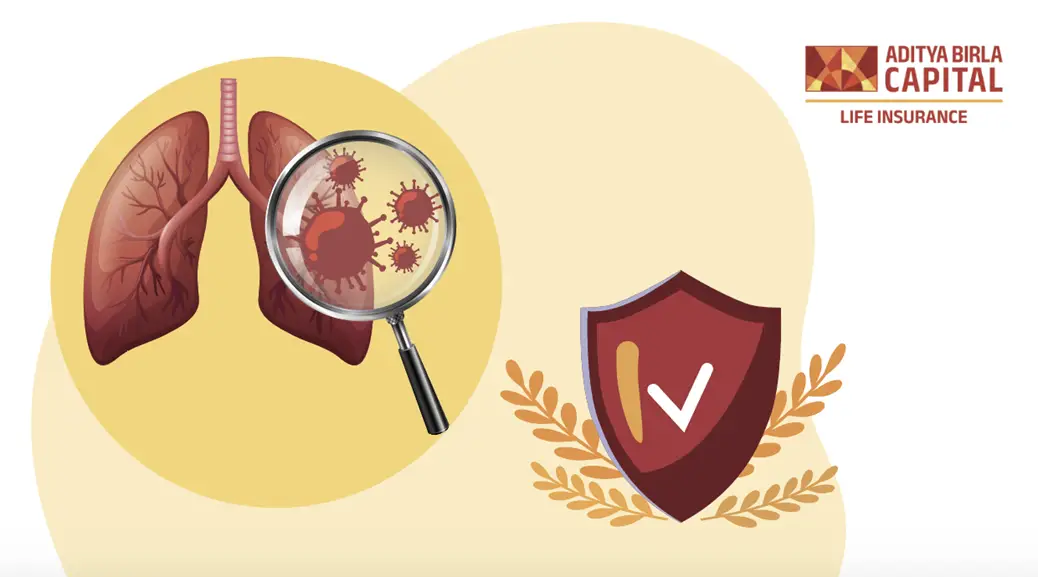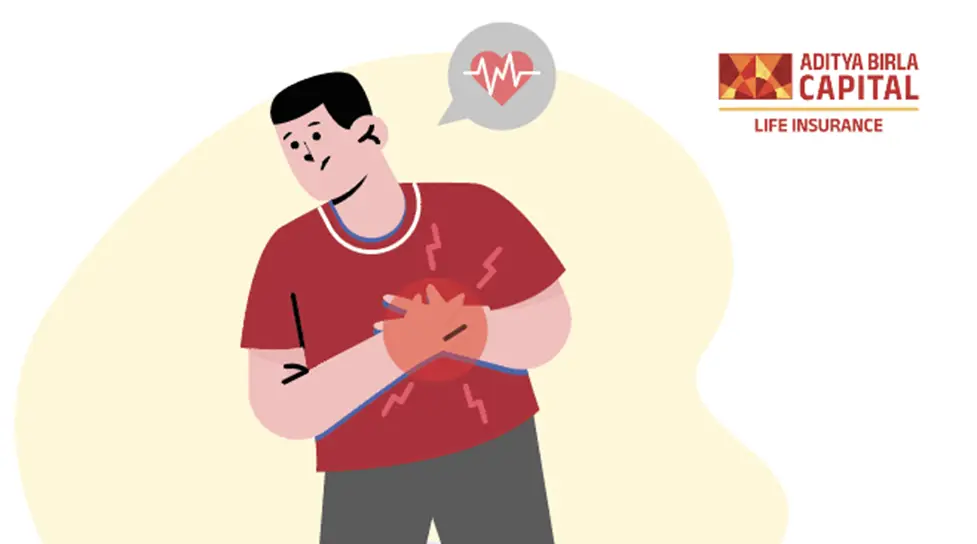Aditya Birla Sun Life Insurance Company Limited
What Are The Risk Factors For Lung Cancer?

Plan Smarter, Live Better!

Thank you for your details. We will reach out to you shortly.

Currently we are facing some issue. Please try after sometime.


- Table of Contents
Lung cancer poses a grave threat, costing millions of lives globally. Research suggests that lung cancer is the formidable champion of cancer deaths, claiming a staggering 1.8 million lives (18%) in 2020.1
Behind the curtains of lung cancer, there is an intricate puzzle that is shaped by diverse risk factors. Some of them, like smoking tobacco products and your family history, are important pieces that influence the development of the disease. Therefore, the need of the hour is to arm yourselves with knowledge about the risk factors associated with lung cancer. This will help you fortify yourself against this stealthy adversary.
In this article, we will explore lung cancer, its symptoms, risk factors and preventive measures to help you pave a brighter future.
Understanding The Risk Factors For Lung Cancer
Here’s a list of the factors that contribute to the development of lung cancer
Secondhand Smoke Effects
If you don't smoke yourself, being around others who do can still pose a risk to your health. Secondhand smoke, the smoke from someone else's burning cigarette or exhaled by smokers, can increase your chances of getting lung cancer.
Family History
Your family history can also play a role in your lung cancer risk. If your close family members have had lung cancer in the past, you might have a slightly higher chance of developing the disease.
Environmental Risk Factors
Environmental factors can also influence our risk of developing lung cancer, and here are some important ones to be aware of -
-
Atomic Bomb Radiation: When atomic bombs explode, they release powerful radiation that can be harmful to human health. Survivors who were exposed to high levels of this radiation were found to have an increased risk of developing lung cancer.2
-
Previous Radiation Therapy: Radiation therapy is sometimes used to treat other types of cancer, and those who have undergone this treatment on the chest area have a higher risk of developing lung cancer later in life.
-
Radon Gas: There is a radioactive gas called radon that occurs naturally in the environment. It is produced when uranium breaks down in soil, rocks, and water, making its way into the air we breathe. Radon can seep into homes and buildings, and prolonged exposure to high levels of this gas is a significant risk factor for lung cancer, especially for those who also smoke.
Workplace Exposure
If you work in certain industries or settings and get exposed to harmful substances like asbestos, uranium, arsenic, diesel exhaust, coal products, nickel, and certain other chemicals, you have a higher likelihood of developing lung cancer.
Air Pollution
Living or working in areas with high levels of outdoor air pollution such as Industrial emissions, vehicle exhaust, and other pollutants can also pose a high risk of lung cancer.
What Are The Symptoms Of Lung Cancer?
Lung cancer symptoms can be tricky to recognise because they often resemble other, less serious illnesses. While some people might not experience any symptoms until the disease has progressed, others may have early warning signs.
Here are some common lung cancer symptoms to be aware of
- Persistent or worsening cough
- Trouble breathing or shortness of breath (Dyspnea)
- Chest pain or discomfort
- High-pitched or whistling sound while breathing
- Appearance of blood while coughing
- Raspy or rough voice
- Loss of appetite
- Loss of body weight
- Extreme tiredness or lack of energy
- Shoulder pain
- A swelling in your face, neck, arms, upper chest (superior vena cava syndrome)
- Small pupil and drooping eyelid in one eye. This may be accompanied by little or zero sweating on that particular side of the face (Horner's Syndrome)
What Are The Types Of Lung Cancer?
Lungs are affected by several cancers; however, there are two main types of it -
Non-Small Cell Lung Cancer (NSCLC)
There are three types of cancers in this category -
-
Adenocarcinoma: This is the most common type and is found in the outer regions of the lungs. It is frequently found in non-smokers and can potentially spread to other organs in the body.
-
Squamous Cell Carcinoma: This type of lung cancer starts in the lining of the bronchial tubes. It is usually linked to a history of smoking and may cause symptoms like coughing, breathing difficulty, etc.
-
Large Cell Carcinoma: This is the lesser common type defined by large, abnormal-looking cancer cells. It can originate in any part of the lung and has the tendency to proliferate and spread very fast.
Small Cell Lung Cancer (SCLC)
This has a rare probability of occurrence but is more aggressive than non-small cell lung cancer (NSCLC). It is strongly linked to smoking and has a tendency to grow rapidly and spread to different parts of the body, including the lymph nodes and distant organs. But, the good news is that small cell lung cancer responds well to chemotherapy and radiation therapy initially, offering a ray of hope.
Other Types Of Cancer In The Lungs
In addition to the above cancers, other types can affect your lungs too
-
Lymphomas: These are the cancers that originate in the lymph nodes.
-
Sarcomas: These cancers develop in your bones or soft tissues.
-
Pleural Mesothelioma: This type of cancer forms in the lining of your lungs.
How Can You Prevent Lung Cancer?
Lung cancer prevention can be done best by avoiding smoking altogether. So, if you are a smoker, quit it, as that will lower your risk significantly. Also, try to stay away from secondhand smoke as well.
The World Health Organization (WHO) suggests two types of preventive measures for lung cancer3
-
Primary Prevention Primary prevention focuses on preventing the disease by reducing risks and promoting healthy habits. These preventive measures include -
-
Quitting smoking
-
Encouraging smoke-free environments
-
Implementing regulations to control the use and distribution of tobacco products.
-
Reducing exposure to harmful substances in the workplace.
-
Taking steps to improve the quality of the air we breathe.
-
Secondary Prevention Secondary prevention involves screening methods to detect lung cancer at an early stage, even before symptoms become noticeable. This is especially beneficial for high-risk individuals, as early detection increases the chances of successful treatment and better outcomes.
Conclusion
In the battle against lung cancer, knowledge is power. Therefore, it is essential to understand the disease and its risk factors, such as smoking, secondhand smoke, family history, environmental hazards, etc. and take proactive measures to reduce the odds. With the right knowledge and the right lifestyle changes, you are giving yourself the power to prevent lung cancer and live a life of health and wellness.
Thank you for your details. We will reach out shortly.
Thanks for reaching out. Currently we are facing some issue.
Give ₹1,00,000 for 6 years
and Get ₹14.48 lakhs#
ABSLI Akshaya Plan
Whole Life Insurance with Cash Bonus
Flexible Bonus Payouts
Two options for benefit payouts
Life Cover
Tax Benefits^
Give:
₹1 lakh for 6 years
Get:
₹14.48 lacs#
Most Popular Calculators
Most Read Articles
How to Calculate Gratuity for Private Sector Employees How to Calculate Gratuity for Private Sector Employees How to Calculate Gratuity for Private Sector Employees How to Calculate Gratuity for Private Sector Employees How to Calculate Gratuity for Private Sector Employees How to Calculate Gratuity for Private Sector Employees







